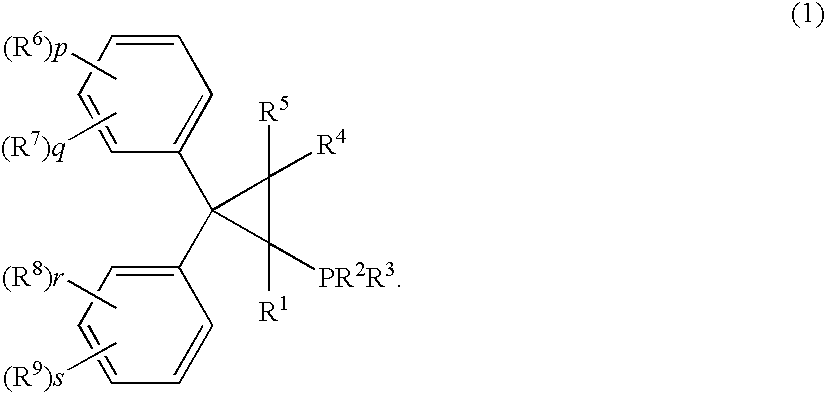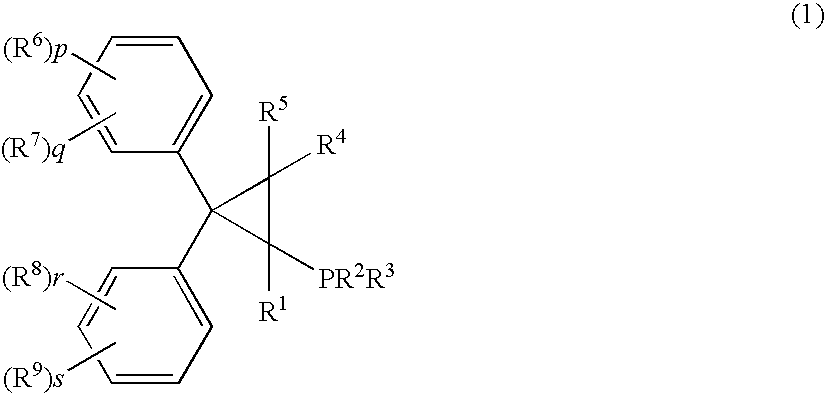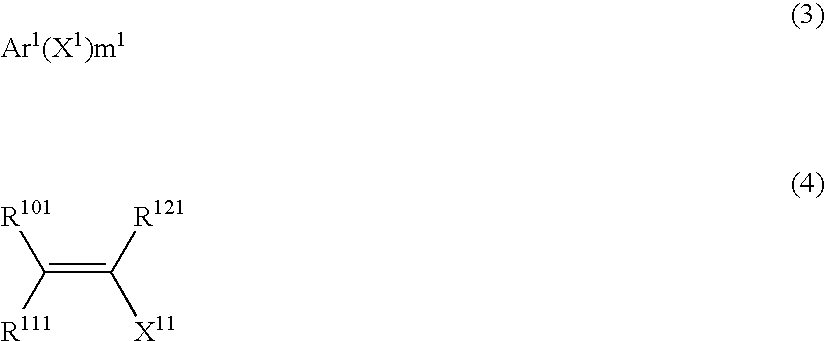Phosphine compound, its intermediate, its complex with palladium and a manufacturing method of unsaturated compounds by using the palladium complex
a technology of unsaturated compounds and compound compounds, which is applied in the field of phosphine compound, its intermediate and its complex with palladium, can solve the problems that the known phosphine ligands may, in some cases, be insufficient, and achieve the effect of reducing the yield of unsaturated compounds obtained by the manufacturing method of the present invention and complicating the work-up procedur
- Summary
- Abstract
- Description
- Claims
- Application Information
AI Technical Summary
Benefits of technology
Problems solved by technology
Method used
Image
Examples
example 1
Preparation of 2,2-diphenyl-1-(diphenylphosphino)-1-methylcyclopropane
[0156](1) Preparation of 1,1-dibromo-2,2-diphenylcyclopropane
[0157]Under a nitrogen atmosphere, potassium tert-butoxide (14.8 g, 132 mmol), diphenylethylene (13.2 g, 73.3 mmol) and hexane (75 ml) were placed in a reaction flask and cooled to −5° C. To this, bromoform (24.1 ml, 95.4 mmol) was added gradually, and the mixture was stirred at the same temperature for 30 minutes. Then, water was added to the reaction mixture and the organic layer was extracted with toluene. The toluene extract was dried over anhydrous magnesium sulfate and then the solvent was removed under reduced pressure. The residue was recrystallized from a mixed solvent of isopropanol and toluene to give the title compound (14.4 g, 56%) as white crystal.
[0158]1H-NMR(CDCl3) δ 2.47(s, 3H), 7.16–7.37(m, 6H), 7.46–7.57(m, 4H).
[0159](2) Preparation of 1-bromo-2,2-diphenyl-1-methylcyclopropane
[0160]Under a nitrogen atmosphere, 1,1-dibromo-2,2-diphenylc...
example 2
Preparation of 2,2-diphenyl-1-(diisopropylphosphino)-1-methylcyclopropane
[0165]Under a nitrogen atmosphere, 1-bromo-2,2-diphenylcyclopropane (1.43 g, 5.0 mmol), magnesium (0.133 g, 5.5 mmol) and THF (10 ml) were placed in a reaction flask, followed by addition of a trace amount of iodine and stirring at 40° C. for 1.5 hours. After cooling, copper iodide (0.952 g, 5.0 mmol) and chlorodiisopropylphosphine (0.80 ml, 5.0 mmol) were added and the resulting mixture was stirred at 40° C. for 5 hours, followed by cooling to room temperature. The resulting mixture was diluted with hexane (20 ml) and crystal separated was collected by filtration. The crystal was dissolved in toluene, and the toluene solution was washed with a 28% aqueous ammonia and a brine, and dried over anhydrous magnesium sulfate. Then, the solvent was removed under reduced pressure to give the title compound (1.06 g, 66%) as white crystal.
[0166]1H-NMR(CDCl3) δ 1.10–1.45(m, 16H), 2.20–2.46(m, 3H), 7.12–7.54(m, 10H); 31P-N...
example 3
Preparation of 2,2-diphenyl-1-(di-tert-butylphosphino)-1-methylcyclopropane
[0167]Under a nitrogen atmosphere, 1-bromo-2,2-diphenyl-cyclopropane (1.44 g, 5.0 mmol), magnesium (0.134 g, 5.5 mmol) and THF (10 ml) were placed in a reaction flask, followed by addition of a trace amount of iodine and stirring at 40° C. for one hour. After cooling, copper iodide (0.962 g, 5.0 mmol), lithium bromide (0.567 g, 6.5 mmol) and chlorodi-tert-butylphosphine (0.95 ml, 5.0 mmol) were added and the resulting mixture was stirred at 60° C. for 3 hours, followed by cooling to room temperature. The resulting mixture was diluted with hexane (20 ml) and crystal separated was collected by filtration. The crystal was dissolved in toluene, and the toluene solution was washed with a 28% aqueous ammonia and a brine, and dried over anhydrous magnesium sulfate. The solvent was then removed under reduced pressure to give the title compound (0.83 g, 47%) as white crystal.
[0168]1H-NMR(CDCl3) δ 1.22(d, J=11.0 Hz, 9H...
PUM
| Property | Measurement | Unit |
|---|---|---|
| reaction time | aaaaa | aaaaa |
| reaction time | aaaaa | aaaaa |
| temperatures | aaaaa | aaaaa |
Abstract
Description
Claims
Application Information
 Login to View More
Login to View More - R&D
- Intellectual Property
- Life Sciences
- Materials
- Tech Scout
- Unparalleled Data Quality
- Higher Quality Content
- 60% Fewer Hallucinations
Browse by: Latest US Patents, China's latest patents, Technical Efficacy Thesaurus, Application Domain, Technology Topic, Popular Technical Reports.
© 2025 PatSnap. All rights reserved.Legal|Privacy policy|Modern Slavery Act Transparency Statement|Sitemap|About US| Contact US: help@patsnap.com



